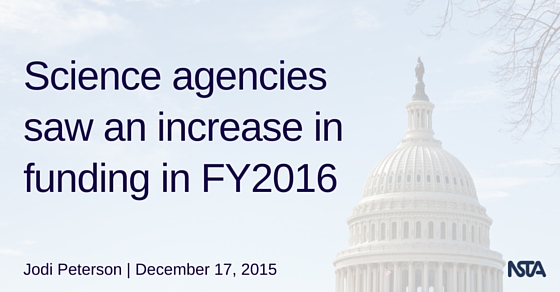Education Gets $1.2 Billion Increase in FY16 Omnibus
By Jodi Peterson
Posted on 2015-12-17
Earlier this week the House Appropriations Committee released the FY 2016 Omnibus Appropriations bill, which provides for discretionary funding for the federal government through the end of the fiscal year, September 30, 2016.
The bill funds the Department of Education at $68 billion, a $1.2 billion increase above the fiscal year 2015 level.
Although the program was not reauthorized in the Every Student Succeeds Act, FY16 funding for the Math and Science Partnerships was $152,717,000. Title II Teacher Quality grants were funded at $2,349,830,000 and 21st Century Community Learning Centers were funded at 1,166,673,000. Congress did not provide funding for Next Generation High Schools, a new program heavily promoted by the Obama Administration.
Title I grants to local school districts received $14.9 billion, an increase of $500 million above the 2015 level. Funding for the Individuals with Disabilities Education Act would increase by $415 million, to $11.9 billion total. See the chart of funding for FY2016 STEM federal programs.
A tax proposal would extend the teacher tax credit that allows teachers to deduct out-of-pocket classroom expenses through the end of 2016, and adjust the $250 tax credit for inflation in future years.
Overall funding for the science agencies was very positive this year. The National Science Foundation saw a modest 1.6 percent funding increase, up $119.3 million for a total budget of $7.46 billion for FY2016. NSF’s education programs received $880 million, a $14 million increase from last year. STEM+C Computer Science Partnerships Program was level funded at $57 million.
NASA saw a 7.1% increase in funding, the NOAA increase was 5.8 %, and the increase for funding for the National Institutes of Standards and Technology (NIST) was 11.6 %. The Department of Energy Office of Science received a 5.5 % increase, while funding for the DOD Science and Technology will increase 8.2%.
The House of Representatives is expected to vote on the funding package this Friday, December 18, with a Senate vote shortly thereafter. The government is currently being funded with a short term stop gap funding resolution that will expire on December 22.
What’s Next for the Every Student Succeeds Act?
What’s ahead for the new federal education law, the Every Student Succeeds Act, now that the president has signed the bill into law?
States and schools will have to transition to the new law from No Child Left Behind. The waivers to NCLB provided to states will be void by August 1, 2016, and the new federal law is expected to be in place beginning in the 2017-18 school year. Some issues in the new law will require the Department to do negotiated rulemaking, a process where representatives from the Department of Education and members from the education community meet to negotiate the terms of the new law.
Education Secretary Arne Duncan said the Department will send out guidance to states on the new law and next steps for implementation soon.
Jodi Peterson is Assistant Executive Director of Legislative Affairs for the National Science Teachers Association (NSTA) and Chair of the STEM Education Coalition. e-mail Peterson at jpeterson@nsta.org; follow her on Twitter at @stemedadvocate.
The mission of NSTA is to promote excellence and innovation in science teaching and learning for all.
Follow NSTA
Disclaimer: The views expressed in this blog post are those of the author(s) and do not necessarily reflect the official position of the National Science Teaching Association (NSTA).



